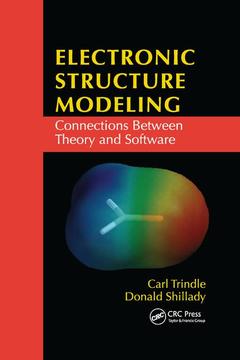Electronic structure modeling: Connections between theory & software Connections Between Theory and Software
Langue : Anglais
Auteurs : Trindle Carl, Shillady Donald

Electronic Structure Modeling enables non-specialists to employ computational chemistry methods, including electronic structure calculations, to their investigations. Featuring electronic structure codes, this unique text illustrates theoretical methods with numerical detail and model calculations. It clarifies what these modeling programs can do, their known pathologies, which ones are suited for specific kinds of projects, and how to reproduce them using the accompanying PC-LOBE bundled software. While elucidating gradient-based molecular structure optimization, this text reviews notable successes and unsolved problems or failures in electronic structure modeling. It includes numerous tables, graphs, and figures throughout.
Brief Conceptual History. Exactly Soluble Model Problems. The H Atom and Perturbations in the Basis of Eigenfunctions. Many Electron Atoms. Roothaan Equations for SCF-LCAO. Geometry Optimization. Properties Interpretable as Derivatives and Optimization Methods. Configuration Mixing for Be Atom. Excited States Represented in the Space of Single Excitations. CAS Methods. Overview of Quantum Monte Carlo Methods. Circular Dichroism, Optical Rotation and Magnetic Circular Dichroism Calculations for Organic Molecules. Coupled Pair and Coupled Cluster Methods. Density Functional Theory. Recent Advances in DFT Functionals. Improved Methods for Excited States, Open Shells, and Other Difficult Cases. Prospects, Pitfalls, and Opportunities in Electronic Structure Modeling.
Non-specialists (such as organic/inorganic chemists and spectroscopists) using modeling software to calculate molecular structure and energetics; students, researchers, and practitioners in computational sciences and atomic/molecular physics.
Trindle, Carl; Shillady, Donald
Electronic Structure Modeling enables non-specialists to employ computational chemistry methods, including electronic structure calculations, to their investigations. Featuring electronic structure codes, this unique text illustrates theoretical methods with numerical detail and model calculations. It clarifies what these modeling programs can do, their known pathologies, which ones are suited for specific kinds of projects, and how to reproduce them using the accompanying PC-LOBE bundled software. While elucidating gradient-based molecular structure optimization, this text reviews notable successes and unsolved problems or failures in electronic structure modeling. It includes numerous tables, graphs, and figures throughout.
Date de parution : 09-2019
15.6x23.4 cm
Disponible chez l'éditeur (délai d'approvisionnement : 12 jours).
Prix indicatif 77,90 €
Ajouter au panierDate de parution : 05-2008
Ouvrage de 336 p.
15.6x23.4 cm
Thème d’Electronic structure modeling: Connections between... :
© 2024 LAVOISIER S.A.S.



